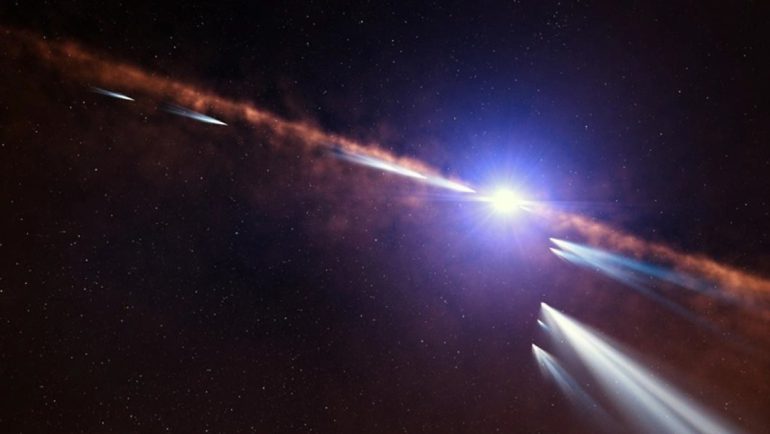in orbit of a distant star
Researchers discover 30 tail stars
April 28, 2022, 4:50 pm
Near the star Beta Pictoris, researchers are encountering dozens of exocomets. Using a special technique, they can prove their size for the first time. From this, scientists parallel the creation of our solar system.
A team of researchers from France, Brazil and the Netherlands has detected 30 comets near the star Beta Pictoris, 63 light-years away, using the US space telescope TESS. For the first time, astronomers were able to analyze the size distribution of tail stars from another star. Exocomets, which are between 3 and 14 kilometers in size, show a distribution similar to that of our Solar System – and therefore must have originated in a similar way, Write Scientists in “Scientific Reports” Magazine,
Beta Pictoris is a young star still surrounded by a disk of gas and dust where planets may still be forming. Astronomers have so far discovered two massive planets in the system – and traces of comets as well. Alain Lecavalier des Etangs of the Sorbonne University in France and his colleagues said, ‘Comets have been found to pass in front of the star as seen from Earth for 30 years.
Comets give themselves away as their gas and dust tails swallow up starlight at certain wavelengths on these transits – and this absorption is then visible as dark lines in Beta Pictoris’ spectrum. Scientists have now used a different observation method: With NASA’s TESS (Transiting Exoplanet Survey Satellite) telescope, they have monitored the star’s brightness with high accuracy for 156 days.
The brightness allows to draw conclusions about the size
TESS is used to search for planets near other stars: if such a planet passes in front of a star as seen from Earth, it weakens the starlight slightly and thus manifests itself. does. The transit of a comet with its large tail also causes such attenuation – albeit less. The researchers were able to identify a total of 30 such comet transits in the TESS data. Based on the strength of the dilution, they were also able to estimate the size of the comet.
This made it possible for the first time to determine the size distribution of comets near another star. “The 16 comets have a diameter of three to four kilometers – but only four are between six and eight kilometers in size and only one is between eight and ten kilometers in size,” report the scientists. Therefore smaller comets are more common in Beta Pictoris than larger comets. Thus the distribution is similar to that of our solar system.
To researchers, this is a sign that the formation and evolution of the comet in Beta Pictoris was similar to our planetary system. Such a distribution of sizes occurs when celestial bodies often collide and break up – but sometimes re-merge to form larger bodies. This is an important finding for astronomers, as comets may have brought a large body of water into the inner Solar System and thus to Earth. So such processes should happen in other planetary systems in a similar way.

Internet fan. Alcohol expert. Beer ninja. Organizer. Certified tv specialist. Explorer. Social media nerd.





